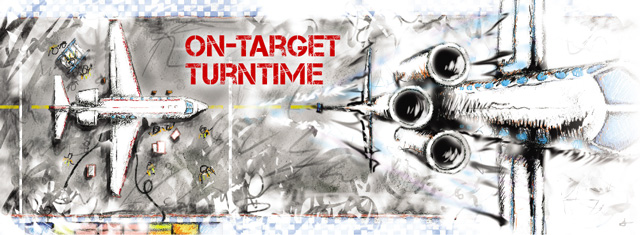
When launching a rocket, every portion of the project must be planned and executed perfectly. And when things don’t go exactly by the book, those in charge of managing the launch must have the flexibility, knowledge and authority to choose the best options from all available strategies.
At the core, rocket launches are not that different from business aircraft service projects. Squawks, parts availability, schedule changes, and additional work are all thrown at the typical project teams working on business aircraft in Duncan Aviation’s hangars. Yet these teams know they need to find and explore all options and strategies to complete the projects when promised. After all, aircraft schedules are so vital that many CEOs, maintenance managers and flight directors cringe at the thought of putting an aircraft down for maintenance.
Based on customer requests and feedback, Duncan Aviation developed efficiency initiatives with the goal of reducing project turntimes and getting customers back in the air on their promised delivery date. Just as important as the faster turntimes, though, is the company’s excellent project management record and the fact that Duncan Aviation completion dates really do mean out-dates for the aircraft.
“One of our main goals for 2014 was to increase project efficiency and cut days off of major airframe work. This gets our customers back in the air faster. However, we keep our excellent customer service and same great quality work,” says Dale Hawkins, a Falcon service sales representative for Duncan Aviation.
The first project under this plan was a Falcon 2000EX recently completed at Duncan Aviation. The workscope—a 1C Check inspection and due items, along with EASy II provisioning—was completed in just 21 days. That’s a full seven days shorter than the typical Duncan Aviation turntime for that inspection. And that means the customer’s asset was ready for use again a full week earlier than usual.
The on-target C Check was completed with lots of forethought and planning by Falcon crew lead RJ Riedel and his teams located at the company’s Battle Creek, Michigan, facility. The same methods used to maximize efficiency on the project are repeatable for similar projects at other locations.
To meet the turntime goal, RJ and his team focused on efficiency and planning. They planned for necessary tooling, parts and support equipment to be available and ready when they needed it. They shifted their work schedules, changing technician hours and implementing staggered breaks and alternate shifts, allowing the aircraft project to be in work nearly 24 hours a day. And they took advantage of tools like electronic work order enhancements and a smooth and pre-approved path for potential squawks, all with the goal of giving technicians uninterrupted time to complete the work.
“The energy on this project was amazing,” RJ says. “All of the team members were excited to work on this, and we kept the promised delivery date in mind at all times while ensuring we kept our work standards at Duncan Aviation quality. We are able to deliver such top quality because we have dedicated team members who understand the value of time to our customers and who take pride in their work and our finished product.”
RJ goes on to say the team was acutely aware that their work on this inspection was ground breaking.
“This particular project’s turntime set a new standard for the industry, along with a remarkable effort from the avionics installation teams to keep pace with the EASy II provisioning,” Dale says. “The efforts of our teams to take the goal of reducing C Check turntimes and turn it in to a success story are astounding. Their creativity and follow-through is a great lesson and shows why Duncan Aviation technicians are a class apart from the norm.”
In order to be counted as a true success, though, a project needs to be successful from the eyes of the customer.
John Johnson, director of maintenance for LJ Aviation in Latrobe, Pennsylvania, and operator of the Falcon 2000EX, was committed to support the project from his end. He understood the importance of timely approvals during the event. By utilizing his myDuncan account, he was able to provide immediate approval for most squawks and monitor the project daily.
“Time is everything,” he says. “The time an aircraft is down is time it is not making money and serving our customers. That Falcon 2000EX has a steady schedule, so we were excited about the 21-day plan.
“However, timing is nothing if the work isn’t safe. Safety is our top concern. We went over the process with Duncan Aviation, and we were comfortable that the proper procedures would be followed and the great quality they’ve provided on other projects would extend to this one as well. We ended up with the full package—fast turntime, high quality, excellent paperwork and great customer service.”
Excellent project management, constant corrections by the technical teams to keep work on-target, and committed customer support and planning helped launch this 21-day Falcon C Check and get the aircraft on its way when promised.
The Duncan Aviation 21-day 1C inspection can be offered to operators with a Falcon 2000EX or 900EX series, using a standard Dassault Chapter 5 inspection program and a minimum two-month planning process.
Operators who take advantage of this offer can choose some additional work to be performed with the inspection without increasing turntime. Additional work can include Falcon Wing Tank Modifications, avionics installations and interior items.